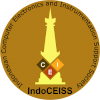Gerga Orange Quality Using Naïve Bayes Based on Feature Extraction
Abstract
Full Text:
PDFReferences
E. K. Ratnasari and A. Wikaningrum, “Pengenalan Jenis Buah pada Citra Menggunakan Pendekatan Klasifikasi Berdasarkan Fitur Warna Lab dan Tekstur Co- Occurrence,” J. Inf., vol. 1, no. 2, pp. 88–97, 2016.
P. B. Padol and A. A. Yadav, “SVM classifier based grape leaf disease detection,” Conf. Adv. Signal Process. CASP 2016, pp. 175–179, 2016.
H. Cecotti, A. Rivera, M. Farhadloo, and M. A. Pedroza, “Grape detection with convolutional neural networks,” Expert Syst. Appl., vol. 159, p. 113588, 2020.
Y. Ji, Q. Zhao, S. Bi, and T. Shen, “Apple Grading Method Based on Features of Color and Defect,” in Chinese Control Conference, 2018, pp. 5364–5368.
D. Nursantika and F. R. Umbara, “PENGENALAN CITRA BUAH MANGGIS MENGGUNAKAN METODE JARINGAN SYARAF TIRUAN BACKPROPAGATION,” in Seminar Nasional Telekomunikasi dan Informatika, 2016, no. Selisik, pp. 182–184.
S. Musacchi and S. Serra, “Apple fruit quality: Overview on pre-harvest factors,” Sci. Hortic. (Amsterdam)., vol. 234, no. December, pp. 409–430, 2018.
K. Komal and Sonia, “GLCM Algorithm and SVM Classification Method for Orange Fruit Quality Assessment,” Int. J. Eng. Res. Technol., vol. 8, no. 09, pp. 697–703, 2019.
I. U. W. Mulyono et al., “Parijoto Fruits Classification using K-Nearest Neighbor Based on Gray Level Co-Occurrence Matrix Texture Extraction,” J. Phys. Conf. Ser., vol. 1501, no. 1, 2020.
T. Y. Prahudaya and A. Harjoko, “Metode Klasifikasi Mutu Jambu Biji Menggunakan Knn Berdasarkan Fitur Warna Dan Tekstur,” J. Teknosains, vol. 6, no. 2, p. 113, 2017.
P. Rianto and A. Harjoko, “Penentuan Kematangan Buah Salak Pondoh Di Pohon Berbasis Pengolahan Citra Digital,” IJCCS (Indonesian J. Comput. Cybern. Syst., vol. 11, no. 2, p. 143, 2017.
S. F. Kusuma, R. E. Pawening, and R. Dijaya, “Otomatisasi Klasifikasi Kematangan Buah Mengkudu Berdasarkan Warna Dan Tekstur,” Regist. J. Ilm. Teknol. Sist. Inf., vol. 3, no. 1, pp. 17–23, 2017.
S. Y. R. Riska and P. Subekti, “Klasifikasi Level Kematangan Buah Tomat Berdasarkan Fitur Warna Menggunakan Multi-Svm,” J. Ilm. Inform., vol. 1, no. 1, 2016.
A. Ciputra, D. Rosal, I. M. Setiadi, E. H. Rachmawanto, and A. Susanto, “KLASIFIKASI TINGKAT KEMATANGAN BUAH APEL MANALAGI DENGAN ALGORITMA NAIVE BAYES DAN EKSTRAKSI FITUR CITRA DIGITAL,” J. SIMETRIS, vol. 9, no. 1, 2018.
O. R. Indriani, E. J. Kusuma, C. A. Sari, E. H. Rachmawanto, and D. R. I. M. Setiadi, “Tomatoes classification using K-NN based on GLCM and HSV color space,” in 2017 International Conference on Innovative and Creative Information Technology (ICITech), 2017, pp. 1–6.
P. N. Andono, E. H. Rachmawanto, N. S. Herman, and K. Kondo, “Orchid types classification using supervised learning algorithm based on feature and color extraction,” Bull. Electr. Eng. Informatics, vol. 10, no. 5, pp. 2530–2538, Oct. 2021.
A. Nosseir and S. E. A. Ahmed, “Automatic Classification for Fruits’ Types and Identification of Rotten Ones Using k-NN and SVM,” Int. J. Online Biomed. Eng., vol. 15, no. 03, p. 47, Feb. 2019.
F. Liantoni and H. Nugroho, “Klasifikasi Daun Herbal Menggunakan Metode Naïve Bayes Classifier Dan K- Nearest Neighbor,” Junral Simantec, vol. 5, no. 1, pp. 9–16, 2015.
N. Ani Brown Mary and D. Dharma, “A novel framework for real-time diseased coral reef image classification,” Multimed. Tools Appl., vol. 78, no. 9, pp. 11387–11425, May 2019.
G. Saleem, M. Akhtar, N. Ahmed, and W. S. Qureshi, “Automated analysis of visual leaf shape features for plant classification,” Comput. Electron. Agric., vol. 157, no. November 2018, pp. 270–280, 2019.
S. H. Wady, R. Z. Yousif, and H. R. Hasan, “A Novel Intelligent System for Brain Tumor Diagnosis Based on a Composite Neutrosophic-Slantlet Transform Domain for Statistical Texture Feature Extraction,” Biomed Res. Int., vol. 2020, pp. 1–21, Jul. 2020.
J. Amin, M. Sharif, M. Raza, T. Saba, and M. A. Anjum, “Brain tumor detection using statistical and machine learning method,” Comput. Methods Programs Biomed., vol. 177, pp. 69–79, Aug. 2019.
DOI: https://doi.org/10.33633/jais.v8i1.7335
Article Metrics
Abstract view : 119 timesPDF - 75 times
Refbacks
- There are currently no refbacks.
Journal of Applied Intelligent System (e-ISSN : 2502-9401, p-ISSN : 2503-0493) is published by Department of Informatics Universitas Dian Nuswantoro Semarang and IndoCEISS.


Journal of Applied Intelligent System indexed by :
This journal is under licensed of Creative Commons Attribution 4.0 International License.

_.png)






